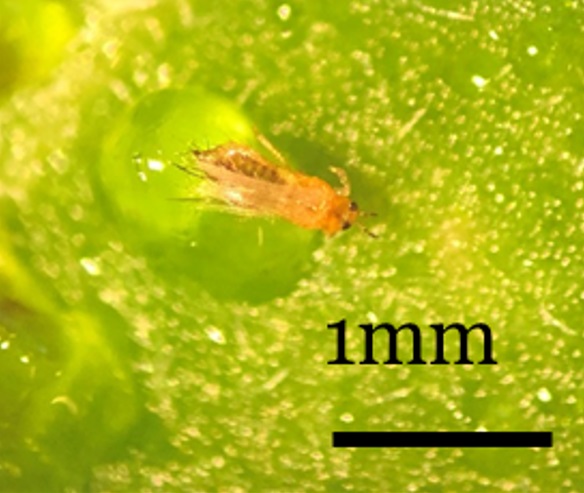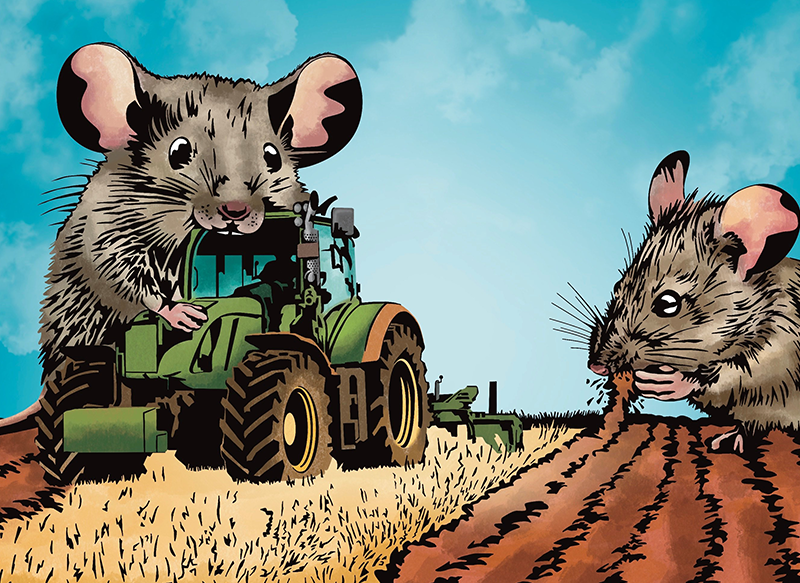If you want to catch flies, you can hang up adhesive strips. When flies land on the strips, they can’t break loose. PhD candidate Ralph van Zwieten has developed something similar to protect horticultural crops against thrips. Instead of hanging up strips, the plants are sprayed with little adhesive balls of oil. He recently won the WUR Research Award for this method.
To be honest, he didn’t think it up himself; he got the idea from nature. Some plants do something similar to protect themselves against insect damage. Sundews are perhaps the best known example, says Van Zwieten. ‘Many plants have tiny hairs called trichomes on their stems and leaves and some of these trichomes act like glands: they secrete moist globules of an adhesive substance. Some plants add an aroma to attract insects, or indeed to repel them.’
Insects that land on a sundew leaf are making a big mistake. They are unable to break loose and the sundew ends up consuming them. Van Zwieten is trying to replicate that adhesive function using environmentally friendly methods. His investigations are part of the research carried out by the Natural Plant Defense consortium, which consists of various companies plus the universities of Wageningen, Groningen and Leiden and the university of applied sciences Aeres in Almere. The aim of the collaboration is to replicate the natural defence system of the trichomes.
Not difficult
It is not difficult to make the substance, but there are extra considerations when applying the method in greenhouse horticulture. The substance used needs to be environmentally friendly, harmless to the plant, something you can spray, and highly specific. That ‘highly specific’ means it has to trap the pest but not its natural enemies or other useful insects such as bees.
Van Zwieten decided to use rice oil and olive oil. He oxidizes the oil so that the unsaturated fatty acids form chains and cross-links. The process changes the liquid oil into an elastic network of adhesive material. ‘The number of unsaturated bonds is important in achieving good adhesion and a good balance between viscosity and elasticity,’ explains Van Zwieten. ‘So when choosing an oil, we look at the composition of the fatty acids. More unsaturated bonds means more cross-links and therefore greater elasticity. Rice oil gives precisely the right balance. Another advantage is that it is already a waste product; it is the oil that is made from rice husks.’ The tough substance that is obtained after oxidation is ground into tiny balls. They are mixed with water and stabilizers to create a kind of ‘smoothie’ that is sprayed onto the plant.
Deep-fat frying
The production process is straightforward chemically. ‘It’s basically deep-fat frying,’ says Van Zwieten. ‘That’s how I often explain it. I heat the oil for a long time. Without any French fries, but even so. If you’ve ever cleaned a deep-fat fryer at home, that final sticky layer on the side of the pan is what I’m making.’ Although it wasn’t as simple in practice as described here. To illustrate that, Van Zwieten opens a cupboard in the lab. It contains the results of all his failed oil cooking experiments, material that is either too hard or not sticky enough. He has kept them as a reminder of all the effort that he had to put in before finally becoming successful.
Because the stuff does work, as tests with chrysanthemums have shown. Van Zwieten: ‘The product turns out to be effective in various ways. Either the thrips are trapped or there’s less insect damage even though they aren’t trapped. We are still investigating why that is. Perhaps the product has a defensive function in some other way.’
Cooking time
The production process might be straightforward but it still takes a long time. The oil only starts to turn viscous after 12 to 14 days at 90oC. ‘In terms of commercial application and energy use, that needs serious consideration,’ acknowledges Van Zwieten. ‘You could reduce the cooking time by adding a desiccant, for example. That is done with the linseed oil used for oil painting, for instance. When that oil dries, chemically what happens is oxidation. As regards the energy aspect, I heat the oil in a glass beaker. If you scaled up, you’d obviously be using large vats in insulating jackets.’
That talk of industrial applications shows what Van Zwieten is aiming at. After getting his doctorate this summer, he will attempt to market his invention. He is already working on a start-up for this — Kairos Green Tech. ‘Kairos is the god of the right moment. The name symbolizes the confidence that things will fall into place at the right time, and that you need to seize the opportunities you get.’

 Image Ralph van Zwieten
Image Ralph van Zwieten 
